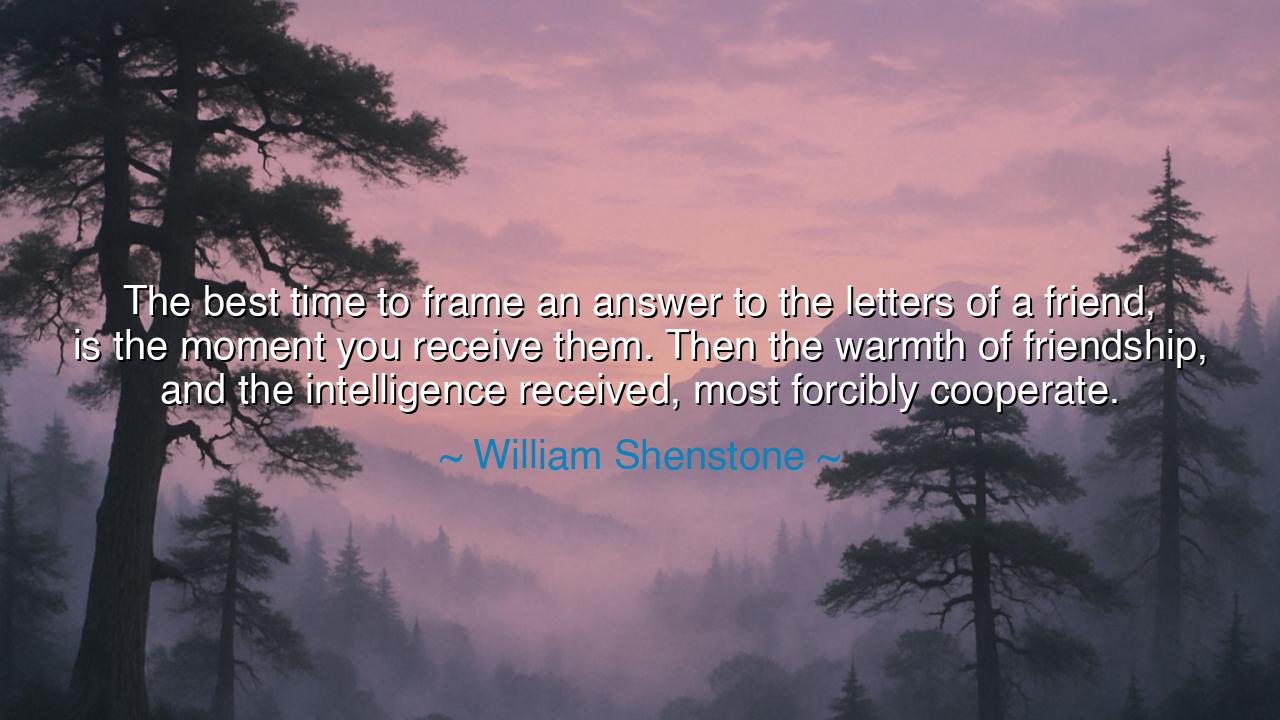
The best time to frame an answer to the letters of a friend, is
The best time to frame an answer to the letters of a friend, is the moment you receive them. Then the warmth of friendship, and the intelligence received, most forcibly cooperate.






"The best time to frame an answer to the letters of a friend, is the moment you receive them. Then the warmth of friendship, and the intelligence received, most forcibly cooperate." These words from William Shenstone offer a timeless piece of wisdom about the art of communication, particularly in the realm of friendship. Shenstone captures the deep, intimate connection that should exist when responding to a friend’s letter. The moment of receipt is not just a passing moment in time—it is a profound opportunity to reflect on the warmth of the friendship and the intelligence conveyed in the letter. This moment, ripe with emotion and thoughtfulness, is when the response should be framed, for in it lies the genuine spirit of friendship, untainted by time or distraction. Shenstone speaks to the importance of timely, sincere communication, where the emotional warmth and thoughtful insights of both parties converge in a response that speaks not only to the mind but to the heart.
In the ancient world, communication between friends was an act of sacredness. The relationship between Plato and his students, for instance, went beyond lectures and formal education—it was a bond of mutual respect, of learning and growth together. Plato often wrote to his students and peers, not only imparting his wisdom but also engaging in deep dialogue that required thoughtful reflection. To respond to a letter was an act of intimacy and intelligence, one that required the receiver to pause, reflect, and then write in kind, with respect to both the content and the emotional intent of the original communication. Shenstone's insight reflects the ancient ideal of thoughtful response—not to answer hastily or out of obligation, but with the full presence of the mind and heart.
Consider the friendship between Cicero and Atticus. Their correspondence was not just a casual exchange of pleasantries, but a deep, ongoing dialogue filled with personal reflections, political insights, and philosophical musings. Each letter was carefully crafted, filled with the warmth of their bond and the intellectual rigor they shared. When Cicero received a letter from Atticus, it was not a mere formality to reply; he took the time to frame his response with care and thought, understanding that the friendship was sustained by the intelligence and emotional investment embedded in their words. Their relationship exemplifies Shenstone’s wisdom: to answer a friend’s letter immediately is to capture the moment when the emotional and intellectual forces of both parties are at their peak—when friendship and wisdom cooperate to produce the truest response.
In the same way, Shenstone's advice invites us to be fully present when we engage with our friends—especially in written communication. A letter is more than just ink on paper; it is a bridge that connects hearts and minds. Shenstone encourages us to honor that connection by responding in the moment of reception, when we are most attuned to the warmth of the friendship and the intelligence that the letter conveys. This is not to suggest that hasty replies should be the norm, but rather that the emotional moment of receiving a letter is one where the heart and mind are aligned, and the response should be as genuine as possible. In our modern world, where digital communication often lacks the personal touch of handwritten words, Shenstone’s lesson is a call to return to the spirit of authenticity in how we respond to those we care about.
The friendship between John Adams and Thomas Jefferson serves as another compelling example of how thoughtful communication shapes deep bonds. After years of political rivalry, their letters began to flow freely once again in their later years. These exchanges were filled with personal reflections, insights about life, and concerns about the future of their young nation. They wrote not out of obligation, but from a place of shared history and mutual respect. Their letters were filled with the intelligence of their minds, but also the warmth of a friendship that had endured through many trials. Each response was a careful reflection of their bond, a dialogue that spanned decades and shaped the course of their personal relationship. This is the kind of exchange Shenstone speaks of—a dialogue where the spirit of friendship and intellectual respect flow together, creating something truly meaningful.
Shenstone’s wisdom holds a powerful lesson for us today: the way we respond to a friend’s communication, whether it is in a letter, an email, or a message, should be framed with the same care, thoughtfulness, and intention that would have characterized the most revered friendships in history. The warmth of friendship should not be coldly or hastily responded to; instead, we should pause, reflect, and give a response that honors both the emotional depth and the intellectual content of what has been shared. In a world that increasingly moves at a fast pace, Shenstone's advice is a reminder that communication should be approached with mindfulness, allowing the bonds we share with our friends to be nurtured in meaningful and lasting ways.
Thus, let us heed Shenstone's words and recognize the power of the moment in which we choose to engage with our friends. Let us frame our responses with the warmth of friendship and the intelligence received, knowing that it is in these moments of true connection that the foundations of lasting relationships are built. Just as the ancient philosophers engaged in dialogues that shaped their lives, so too must we take the time to thoughtfully engage with those we hold dear, for it is through these genuine exchanges that the richest and most rewarding friendships are formed.






AAdministratorAdministrator
Welcome, honored guests. Please leave a comment, we will respond soon